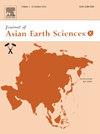伊朗西北部Kamyaran蛇绿岩杂岩的地球动力学和岩浆演化:从大洋俯冲到大陆碰撞的构造转变
IF 2.3
Q3 GEOSCIENCES, MULTIDISCIPLINARY
引用次数: 0
摘要
扎格罗斯造山带的蛇绿岩是新特提斯海洋的遗迹,它存在于罗拉西亚大陆和冈瓦纳大陆之间。关于新特提斯海洋的形成和演化有很多争论。了解其碰撞前的构造演化对精确地确定其时间和历史具有至关重要的意义。Kamyaran蛇绿杂岩是伊朗西北部从Kermanshah到Khoy的中生代蛇绿带的一部分,由几个构造分裂的单元组成,包括橄榄岩透镜体和各种辉长岩。橄榄岩的矿物化学特征表明,它们经历了中等程度的部分熔融(14-18%),并在俯冲相关特征较弱的超俯冲背景下产生了类似morb的熔体。阿拉伯板块东北缘洋内俯冲的开始引起了贫化橄榄岩残余地幔的交代作用。辉长岩呈拉斑—钙碱性特征,Nb、Th、Ti呈负异常,Sr、Ba、U、Eu呈正异常。颗粒状和伟晶状辉长岩由N-MORB组成的母质熔体结晶,具有轻稀土和三稀土模式的轻微耗损。该岩浆起源于贫地幔,具有负Th、负Nb、负Ti异常特征。伟晶状辉长岩与粒状辉长岩的区别在于,辉长岩中稀土元素含量较低,Th、Nb、Ti呈负异常,而Eu正异常较少。微辉长岩脉具有N-MORB亲和力,缺乏负Nb和负Ta异常。地质和地球化学数据表明,在新特提斯闭合之后,从海洋岛弧到大陆弧的过渡环境。该杂岩是在阿拉伯高原和伊朗高原碰撞期间形成的超俯冲带蛇绿岩的一部分。本文章由计算机程序翻译,如有差异,请以英文原文为准。
Geodynamic and magmatic evolution of the Kamyaran ophiolite complex, NW Iran: Tectonic transition from oceanic subduction to continental collision
The ophiolites in the Zagros orogen are relics of the Neo-Tethyan Ocean, which existed between the continents of Laurasia and Gondwana. There is much debate about the formation and evolution of the Neo-Tethyan Ocean. Knowledge on its pre-collisional tectonic evolution is of critical importance in precisely constraining its timing and history. The Kamyaran ophiolitic complex consists of several tectonically dismembered units including peridotite lenses and various gabbroic rocks as part of a Mesozoic ophiolitic belt extending from Kermanshah to Khoy in northwestern Iran. Mineral chemistry of the peridotites indicates that they underwent medium degree of partial melting (14–18%) and produced melts of MORB-like character in a suprasubduction setting with weak subduction-related signatures. The beginning of intra-oceanic subduction in the northeast margin of the Arabian plate caused metasomatism in the residual mantle of depleted peridotites. Gabbroic rocks display tholeiitic to calc-alkaline signatures with negative Nb, Th and Ti and positive Sr, Ba, U and Eu anomalies. Granular and pegmatoid gabbroic rocks with slight depletion of LREE and HREE pattern, crystallized from parental melts of N-MORB composition. This magma, characterized by negative Th, Nb, and Ti anomalies, was generated from depleted mantle. Pegmatoid gabbros are distinguished from granular gabbros by features such as more depleted REE, negative Th, Nb, Ti anomalies and lack of Eu positive anomalies. Microgabbroic dykes show N-MORB affinities and lack negative Nb and Ta anomalies. Geological and geochemical data suggest a transitional setting from oceanic island arc to continental arc following the closure of the Neo-Tethys. The complex is part of the supra-subduction zone ophiolite that emplaced during the collision of the Arabian and Iranian plateaus.
求助全文
通过发布文献求助,成功后即可免费获取论文全文。
去求助
来源期刊

Journal of Asian Earth Sciences: X
Earth and Planetary Sciences-Earth-Surface Processes
CiteScore
3.40
自引率
0.00%
发文量
53
审稿时长
28 weeks
 求助内容:
求助内容: 应助结果提醒方式:
应助结果提醒方式:


